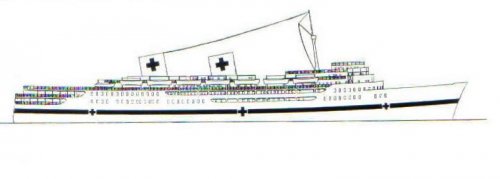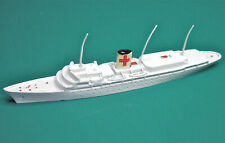I have found some more information on the planned hospital ship. The following information comes from the attached pdf.
1951: 10,000-ton naval hospital ship
proposed naval hospital ship, 10,000 ton design. 04.1951 ordered from Barclay Curle & Co, Clydeholm, 31.01.1952 laid down at No 3 berth as yard number 730. July 1952 the order was cancelled – reasons being austerity, a strict economy and steel shortages. The money and material saved reportedly went into the construction of the Royal Yacht-cum-Hospital Ship Britannia at John Brown’s Clydebank yard. No name was announced for this hospital ship, however, DNC’s Statement of Requirements provides a range of information. This hospital ship was intended to be a twin screw fleet hospital ship with a displacement of 10,600 tons, for service in both tropical and arctic conditions; range 6,000 n.miles. Fully loaded speed of 18 knots so that she could trail a fleet train or replenishment group, be capable of accommodating 350 patients in peace and up to 500 in war. The contractor was to have been responsible for the general design within the Admiralty’s specification and it was understood that a starting point would be the previously abandoned 1939 design. The ship was to be built to classification society rules and supervised by the Society’s surveyors and Warships Production Superintendent. Underwater hull to be shockproof and fore end, at the waterline, appropriately stiffened for service in arctic waters. Accommodation and wards were to be fully air-conditioned with crew cabins to the latest Ministry of Transport (MoT) standards. Lifeboats, lifesaving appliances and fire fighting protection were to meet the 1948 Convention for Safety of Life at Sear requirements(SOLAS 1948). The Admiralty were to supply two 25ft fast motor boats, a 32 ft general service motor cutter and two 14ft sailing dinghies.
Arrangements were to be made, included jackstay for the ‘transfer-at-sea’ of patients, light stores and fuel; interestingly 65ft of the after end of the boat deck was to be specially stiffened for use as a helicopter landing deck; bridge controlled stabiliser system was to be fitted and the Admiralty were to supply a Sperry type gyro compass. She was to have a commercial radio outfit complying with the Merchant Shipping Radio Rules plus a Naval pattern VHF and a commercial type radar.
Her passive defence was to include that all wards were gas tight, air filtration units to be fitted in each watertight sub-division and the means of crash stopping of fans. Degaussing arrangements were to be fitted and a raked stem capable of taking the latest paravane equipment. Interestingly the requirement refers to ‘the dummy funnel’ and that it should be used for air intakes and exhaust purposes.
Records refer to ‘a galley for the RFA’, so it is logical that she would have been civilian crewed as a Royal Fleet Auxiliary. It is, therefore, unlikely that she would have carried any name other than Maine.


